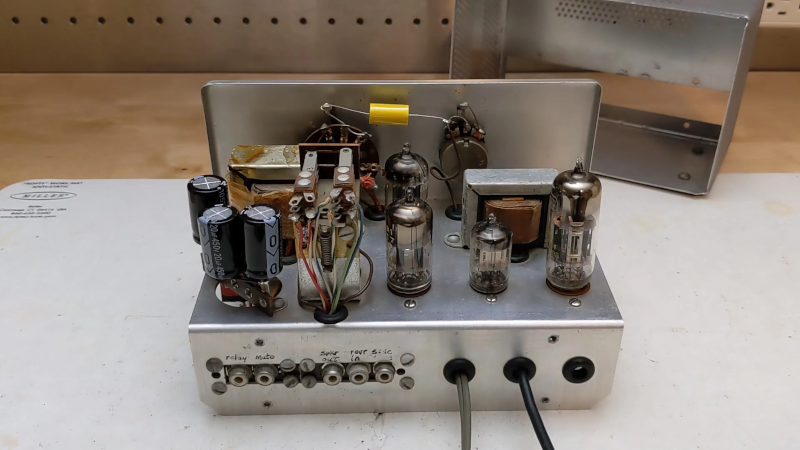Most modern ham rigs have a voice activated transmission (VOX) mode, although we don’t know many people who use it often. When a transmitter is in VOX mode, it starts transmitting when you talk, and then, when you pause for a second or two, the transmitter turns off. Many old ham transmitters, though, didn’t support VOX, so Heathkit sold the VX-1 “electronic voice control” to add VOX to older transmitters. [Jeff Tranter] shows us inside a clean-looking unit.
These devices were sold from 1958 to 1960 and used tubes and a selenium rectifier. The device is connected between the microphone and the transmitter. It also sat between the receiver and the speaker to mute audio while transmitting. The original unit had a screw terminal to connect to the outside world, and some of the screws had live line voltage on them. The unit [Jeff] examines is modified to have phono jacks along with a few other repairs.
The wiring looks like a tube radio. Tubes are above the chassis, and point-to-point wiring is underneath. There is also an unusual sealed selenium rectifier. [Jeff] shows how the device works using just a receiver. A few minor repairs were needed.
If you are interested in getting your ham license, most modern radios support VOX out of the box — no rhyme intended. We do, however, love that old Heathkit gear.















If you have a selenium rectifier and a low-enough resistance load that can also handle a lot of watts… you can make a really great e-incense.
Selenium rectifiers and old TV cascodes surely had the worst smelling magic smoke! Exploding electrolytic capacitors were quite bad also.
Reminds me of a pun older than my dad. Gleichrichter = Gleich riecht er. (Gleichrichter means rectifier; “gleich riecht er” translates to “soon smells he”) 🙂
Indeed! Having had the distinct displeasure and misfortune of getting a face full of selenium-rich magic smoke from old rectifiers burning inside control panels on three occasions in my life, I can confidently say to anyone with even the slightest curiosity that you will never really forget the veritable bouquet of suffering that such forbidden incense will cast upon you any anyone else withing a conspicuously large area for a truly distressing length of time. Even now, the mere mention of selenium rectifiers summons forth the ineffable, textured flavor of a thousand skunks squeezing the evil milk from a million cloves of rotten garlic while sitting atop a mountain of burning tires in the blazing heat of an eternal black sun that never sets on the outer reaches of the abyss itself.
I can see the amazon review of that incense “kinda smelly. 4/5 stars”
I mechanically restore vintage radios to operating condition as a hobby. I typically replace those selenium rectifiers when I run into them just as a overall safetly practice.
The teacher I had in the first year of high school (electronics-shop choice) said if one of those goes kill the power and leave the room! Definitely bad.
I like the tie strip at the hole with modern caps above method. Sometimes there isn’t room under for all 3 caps if not going for the empty can method, otherwise terminals have to substitute for the removed can. There is often a big hot resistor on one or more of those terminals. I work on vintage tube organs. I’ve never gutted an old can ‘lytic.